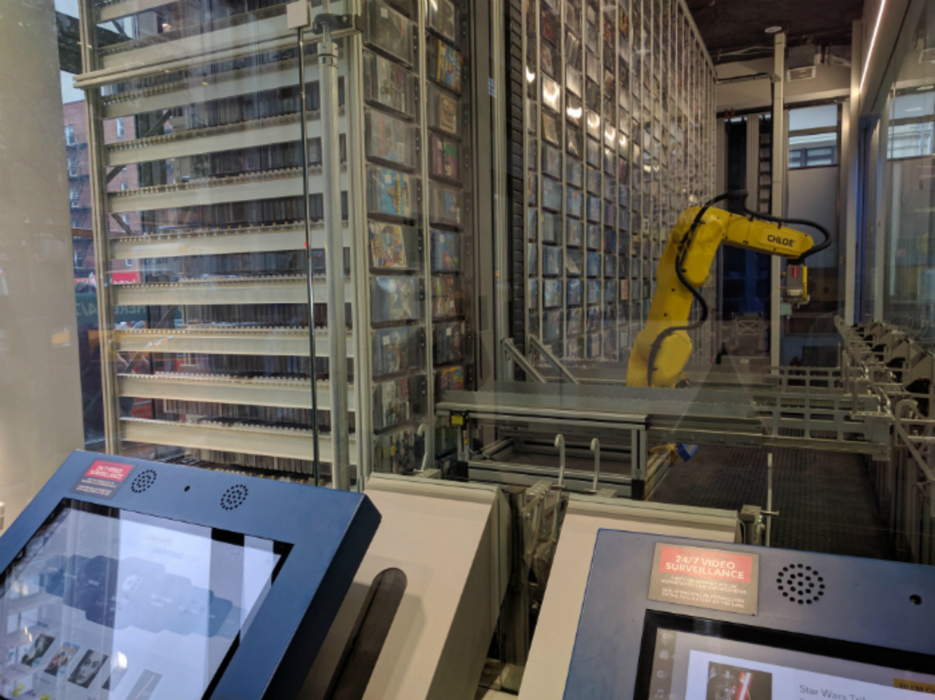It’s been a little over a year since Best Buy announced its most famous associate, Chloe. Chloe works at the electronics retailer’s Chelsea location in Manhattan, she’s there 24/7, and she’s a robot.
It’s also among the retail world’s most experimental efforts to reclaim lost ground in the age of Amazon and rampant ecommerce.
As a system, Chloe is a 350-square foot menagerie of belts, bins, cases, and shelves. The robot itself is a simple industrial robotic arm, complete with a screen that greets shoppers with a hello message, and flashes an emoticon smile upon completing its task. But Chloe’s biggest draw is the convenience she brings to the in-store experience.
With Chloe, shoppers gain access to a sizable chunk of Best Buy’s electronic offerings, specifically movies, TV shows, gadgets, music, and games in a centralized vending machine,RedBox-esque apparatus.
The majority of the 23rd Street Best Buy’s media products are now tucked into the innards of Chloe; a somewhat crude, somewhat novel robot that is neither fully inside the store, nor completely without it, but delivers a detached experience all the same. It’s actually fairly easy to miss Chloe, as well, since it is located so close to the entrance. It can’t be too rare of an occurrence for shoppers to get confused as they venture into the store in search of games or movies, only to find those sections gutted of anything that isn’t a brand new release.
While it’s entirely possible that Best Buy could remedy these issues by building future Chloe’s deeper inside the store, the core problem remains.
Chloe has a magnetic presence. It doesn’t really get old watching the yellow arm wizz about, sorting through hundreds of CDs, DVDs and BluRays, or its assortment of endcap items. Unfortunately, Chole is not as fun to use as it is to watch.
Loosely based on Best Buy’s mobile site, the search interface is tight and cluttered, and the touch screen sometimes behaves like old touch panels from the early 2000s (lagging, not registering input). But the biggest shortcomings lie in the functional deficiencies of Chloe’s search capabilities. The machine flat out doesn’t acknowledge the existence of a film unless it is tucked somewhere within its labyrinth of shelves. Due to an insistence on exact spelling, it’s not uncommon to stare directly at a product on Chloe’s shelves, but not see it in search results.
Indeed, one of the most frustrating aspects of Chloe is her reluctance to admit it doesn’t have something. Searching a product Chloe doesn’t currently carry returns (essentially) the homepage of the interface, instead of a blank page, or some form of messaging that indicates the item is out of stock.
So what is Chloe’s end game and what does it mean for retailers? It’s not exactly clear what will continue to keep retail stores viable and desirable in the wake of 24-7 accessibility of eCommerce like Amazon. But Chloe doesn’t feel like it’s it.
If Chloe is just intended to be a sideshow, it’s not Best Buy’s best foot forward because of the above issues. All told, the act of actually shopping with Chloe is often clunky and confusing.
If Chloe is a trial balloon for a more automated store, then what’s the purpose of a store if you’re just interacting with an interface?
As convenient as Chloe can be, it simply cannot compete with the Amazons of the world, or the many same-day delivery services at play these days, most of whom promise deliveries in an hour or so.








